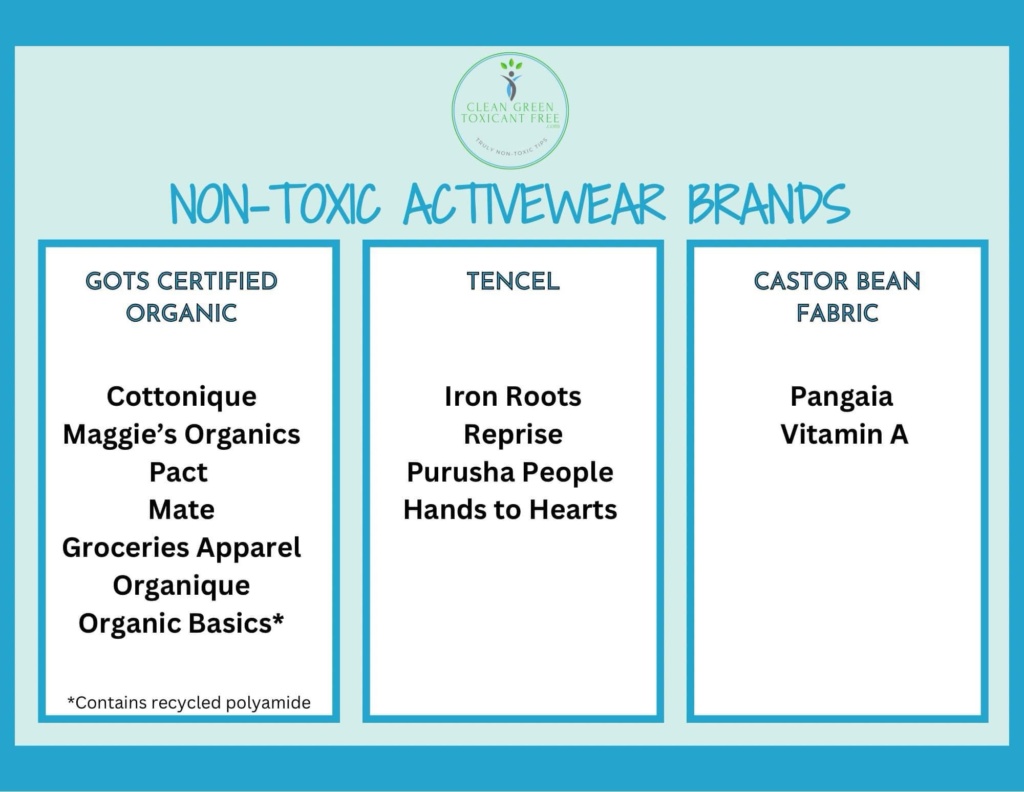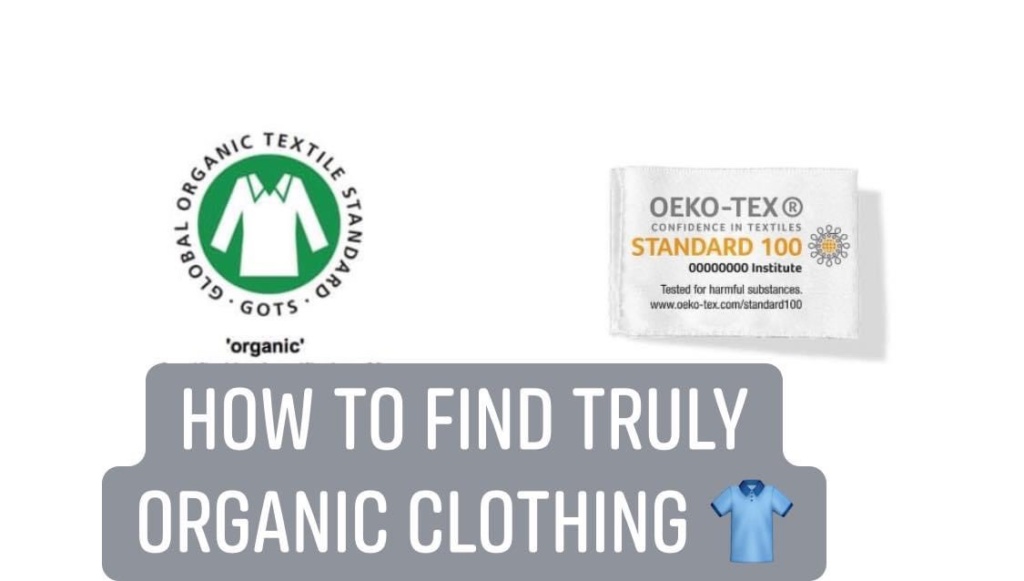Updated July 2024
How to Know if Items are Truly Organic: Certifications
This is paramount information on your non-toxic journey. The word “organic” is NOT regulated for clothing the way it is for food! Food cannot be labeled as organic unless it is certified USDA organic. But no such regulation exists for clothing and other products (like bedding, diapers, fabric baskets, etc), so if you see products with “organic” used in the brand name or product description, you have to verify for yourself if they are certified organic.
This post may contain Amazon Associates and other affiliate links, that I may earn small amounts from. See the bottom of this page for more details.
If you do not see the certification logo on the product tag or packaging, it is likely not organic at all. Even if you ask a seller online about certification, be sure to check for that logo on the product when you receive it. There is also a GOTS database you can check.
- GOTS: The GOTS certification is the top certification for organic cotton or wool clothing. GOTS ensures that the dyes and finishes are non-toxic too. You will see the green GOTS logo on clothing tags or packaging. If a brand claims to use GOTS certified cotton but the end product isn’t certified, that means that the organic cotton is certified but the dyes and finishing are not.
- Oeko-Tex: Oeko-Tex ensures that your clothing is free of hundreds of different chemicals. However, things including certain flame retardants are allowed. Both organic and non-organic fibers are allowed, as well as synthetic materials. Look for the Oeko-Tex label on the product. I made a Facebook post with more info here.
- ZQ: This certification is specific to wool fibers and fabrics. To comply with ZQ standards, wool products must follow the most stringent regulations of sustainable farming, animal welfare, and fair working conditions.
Below are images of the logos so you can easily identify these certifications. You might see two on the same item because if something is GOTS certified it also qualifies as Oeko-Tex (but not the other way around) and some companies pay for both.


List of Organic Clothing Brands for Kids
(Some of them have adult sizes too). My favorite blogger worked hard to create this list. In her words, “Buying organic clothing for babies and kids is so important. The fashion industry is notoriously toxic. Our children’s skin is much thinner than ours which increases the absorption of toxins from clothing. So it’s important to have non-toxic, organic clothing. Buying certified organic clothing is the best for not only our children’s health but also the environment.”
Some of the most affordable brands include the following list I compiled (some with Amazon Associate links as examples of their products; you can search for more):
-Burts Bees (I have bought lots from this brand) https://amzn.to/3GThpnj
-Moon and Back: (I have bought lots from this brand) https://amzn.to/347c8tW
-Mightly Organic (when on sale) I have bought this brand: https://amzn.to/3FRZFY8
-Lamaze (I have bought this brand): https://amzn.to/3qXoBt9
-DorDor and Gorgor: https://amzn.to/32ulcsn
-Tittimitti socks I have bought: https://amzn.to/3450gs6
-Lucky and Me underwear I have bought for my daughter m: https://amzn.to/3tWUTXc. They make other clothes and all their organic cotton items are GOTS certified. Do be aware that some of their items are a cotton blend; read descriptions carefully. Here is their website.
-Little Planet Organic by Carter’s
-Little Star Organic
-PACT (when on sale)
-L’oved Baby (when on sale)
-Little Co (GOTS/Oeko) at Kohls- up to 5t
-Mac and moon (GOTS) at Kohl’s- baby/toddler
-Kite (when on sale)
Here is an additional list of links (not affiliate links):
https://paradebaby.com/GOTS certified, based in Canada, made in India http://www.dunssweden.se/ GOTS, based in sweden
http://littlegreenradicals.co.uk/ based in UK, made in India, they are not GOTS, but work with certified factories.
https://www.kateson.com/ GOTS, made in India https://www.welovefrugi.com GOTS, based in UK
http://www.bellybutton.de/ GOTS
https://www.lovedbaby.com/ GOTS
https://www.welovefrugi.com/ GOTS, based in UK
http://www.kite-clothing.co.uk/ GOTS, based in
UK
https://www.coloredorganics.com/GOTS, USA
https://www.sweetpeanut.com GOTS
List of Organic Clothing Companies for Adults
I’ll try to add to this list slowly. Be aware that some of these companies sell non-organic clothes too, so check each item description carefully.
-Pact
-YesAnd
-Organic Basics
-Mate the Label
-Jolie Kai
Several brands at Kohl’s have items that have GOTS or Oeko Tex certifications in the details. Note that some pieces from each brand are organic and some are not. I haven’t contacted the brands or Kohl’s to double check so you might want to ask if you purchase anything:
-Lauren Conrad (GOTS)- adult
-Human Nation (GOTS)- adult
-Elizabeth and James (Oeko) – adult
-Sonoma – (GOTS) adult and towels
-Madison Park (GOTS) – towels
-The Big One (Oeko/Made in Green) beach towels
-Apt 9 (Oeko Tex) – adults, teens, various
Here is a longer post on adult options.
And here is a post I made about organic activewear options:

I’ll try to get some discount codes:
Here’s a link to Mate the Label: matethelabel.sjv.io/k0x3md
Link to Cottonique: https://www.cottonique.com?sca_ref=6297378.WubZpTkPLn&utm_source=uppromote&utm_medium=referral&utm_campaign=affiliate
These are the Maggie’s leggings I bought. Amazon associates link https://amzn.to/3tkdkHg
Importance of Organic Fabrics
NBM says: The toxins found in [non-organic] clothing are vast. Some of the toxins include:
- AZO dyes (heavy metals including lead)
- Formaldehyde
- Phthalates
- Toxic waterproofing (DWR)
- PFCs (the chemical used to make Teflon)
- Flame Retardants
- Nonylphenol ethoxylate (NPE)
- Chlorine Bleach
- VOCs (Volatile Organic Compounds)
- Ammonia
- Pesticides including glyphosate
- Petroleum fossil fuels
The list of the Commission for Consumer Product Safety – 5 potentially toxic chemicals found in clothing made in China including lead and formaldehyde. Link for how to avoid flame retardant in kids pajamas.
In addition to these toxins being in our clothing, they also end up in our air and waterways during manufacturing. Sadly, they are prolific in our environment. I highly recommend you have a high-quality water filter to help protect you from contaminants in our water supply as well as a high-quality air filter for your home.
-Anything synthetic, such as polyester or microfiber, is fundamentally plastic and can contribute to microplastic pollution. “About 35 percent of the microplastics that enter the ocean come via the synthetic textiles (such as polyester). It also underscored how this is a global problem: Synthetic textiles are more common in developing nations, which often don’t have robust wastewater treatment facilities to filter them out.”
-Beware of fabric touted as eco-friendly; if then these are made from recycled plastic and have the same concerns as synthetic fabric. I explain more about this in my backpack blog.
-Bamboo is touted as sustainable but actually involves a lot of chemicals in the processing. Typically if things are just labeled “bamboo” they’re rayon which undergoes an extremely chemical intensive process to become fabric.
-Wool is often produced with highly unethical and cruel methods. Certified organic wool has protections in place for ethical standards, so in the rare instances that I use wool, I make sure it’s certified organic. The only item I can think of that I own that is wool are these adorable animal dryer balls (affiliate link): https://amzn.to/3HWl0R3
-Tencel, lyocell, and Lenzing modal (modal is derived from beechwood) are all safer, more environmentally friendly options in terms of the process to turn the pulp into clothing fibers. They are still semi synthetic, but significantly better than polyester or acrylic. They claim to use very minimal, and less toxic chemicals compared to conventional bamboo viscose and modal. They also test their finished fabrics to ensure no chemical residue remains and use eco friendly practices. The finished product is still a semi-synthetic, but far less toxic than typical bamboo and modal.
Here is another post on why you should buy organic clothing, which goes into detail on different clothing materials types as well as clothing certifications you need to know about. If you want a deeper dive, I recommend you check out both the organic clothing post mentioned above and this post on clothing certifications. Here’s another blogger discussing certifications too.
Another blogger looked at PFAS in kids clothing in this link.
Be aware that children’s pajamas /pj’s
from ages 9 months to 14 years old are required to be flame resistant. This can be achieved by using fabrics that are naturally flame resistant, or with chemical flame retardants. GOTS organic clothing is a great way to avoid all flame retardants.
Please follow my Facebook page here for more great content:
https://m.facebook.com/CleanGreenToxicantFree/
***Thank you for visiting Clean Green Toxicant Free! I started this site simply because I want to help people and share information. I dig deep and seek the most truly non-toxic products, without bias. I am not paid to write anything and I don’t sell anything. In 2022 I became an Amazon Associate, which does NOT bias my recommendations. I may earn small dividends from purchases made after clicking my clearly labeled links (even if you don’t buy those specific items), which covers the costs I pay to maintain this site, at no cost to you. More info is on the About This Website page.***

